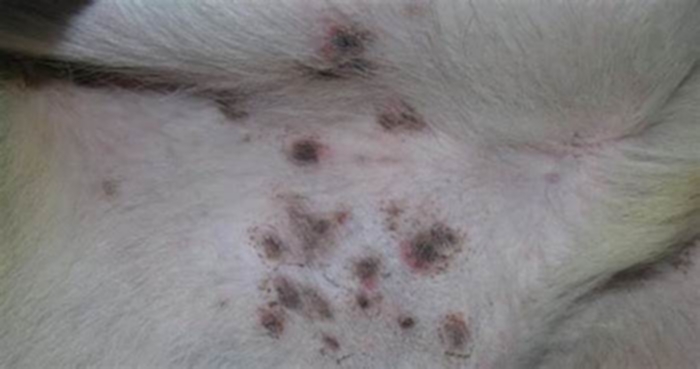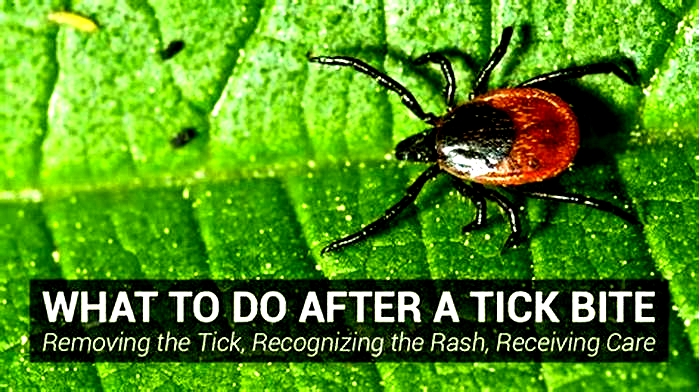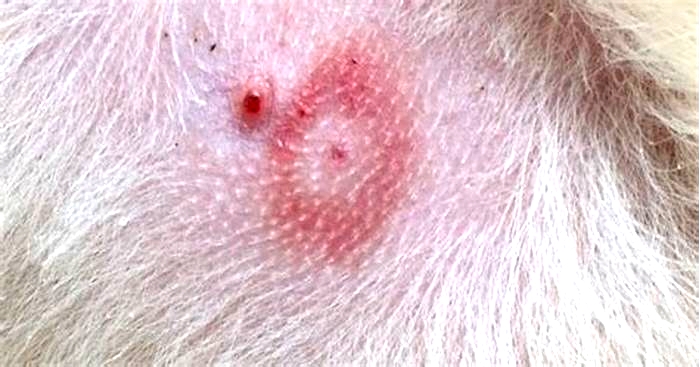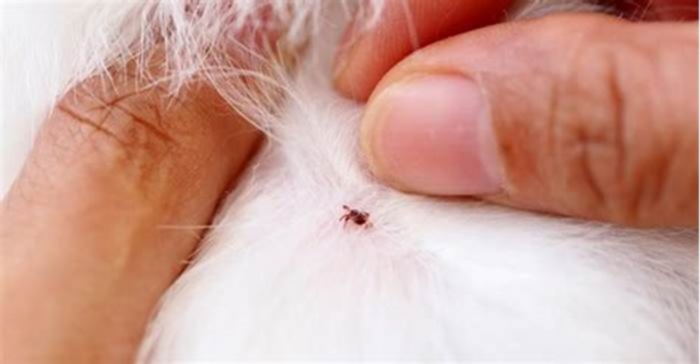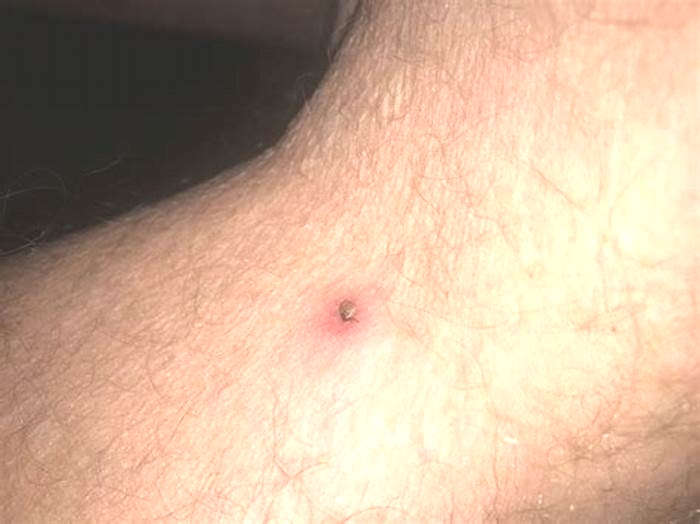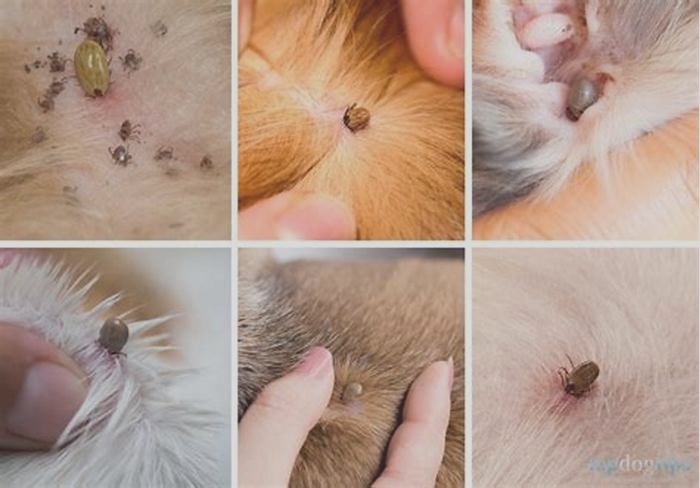How do I know if my dog has a tick or mole
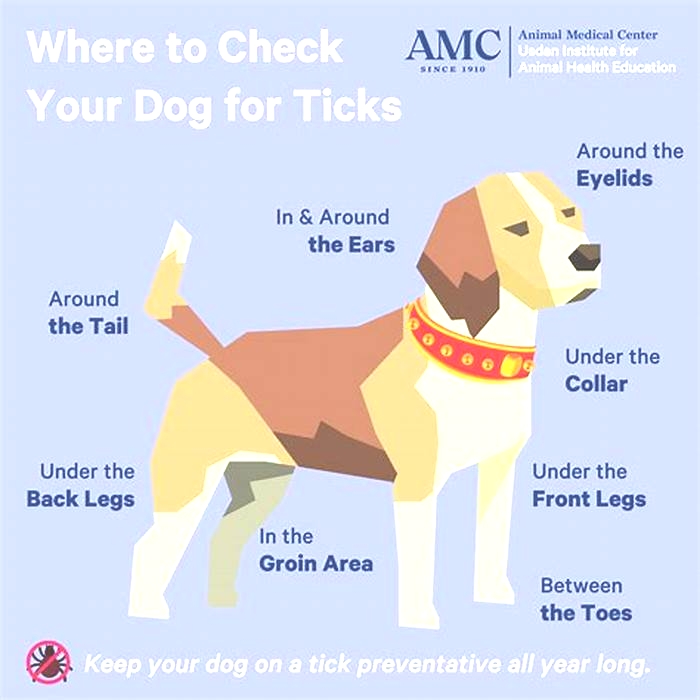
6 Types of Moles on Dogs [With Pics] and What to Do
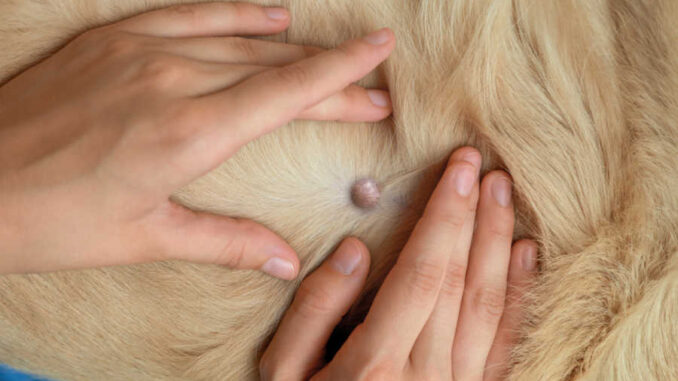
This article was updated on October 16th, 2023
When an owner comes to my clinic because they are worried about a new growth or mole on their dog, the question on everyones lips is, What is it?.
When a new skin lesion resembles a mole, owners will inevitably wonder: do dogs have moles? The answer is yes. However, we refer to them as nevus (singular) or nevi (plural). Some owners and vets, however, will use the word mole interchangeably with skin tag or wart.

Types of moles (with pictures)
Technically, a mole is a nevus. This is a benign skin growth that is usually small and quite symmetrical. Uncommonly, a nevus can be cancerous or can transform into a cancer. Cancerous moles on dogs are quite rare, thankfully.
As mentioned, other types of lesions such as a cyst, skin tag or wart may also be referred to as moles by some people. Lets take a look at some of the more common types of moles or bumps in dogs, with pictures:
Skin Tags
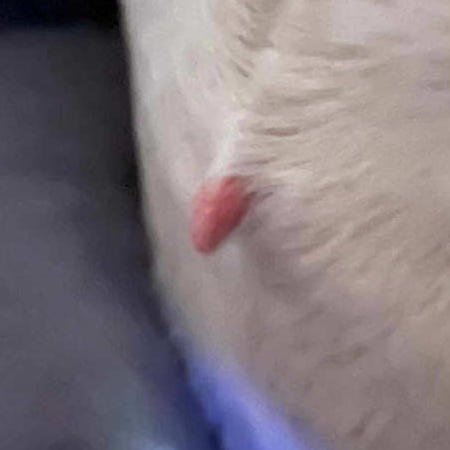
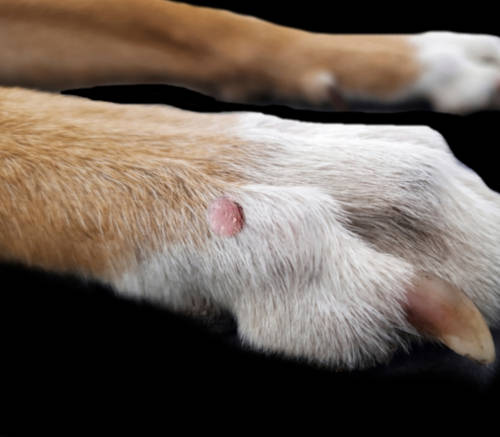
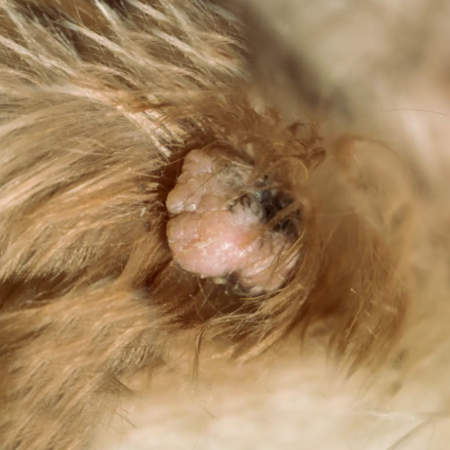
In older dogs especially, skin tags start to appear. We often see them on the face, elbows, armpits, and ankles. They can dangle from the skin and may be dark or a fleshy pink color. They are slow-growing and should not bother the dog.
Generally, we would monitor skin tags but would not remove them unless they were becoming a nuisance. Learn more about Skin Tags.
Cysts
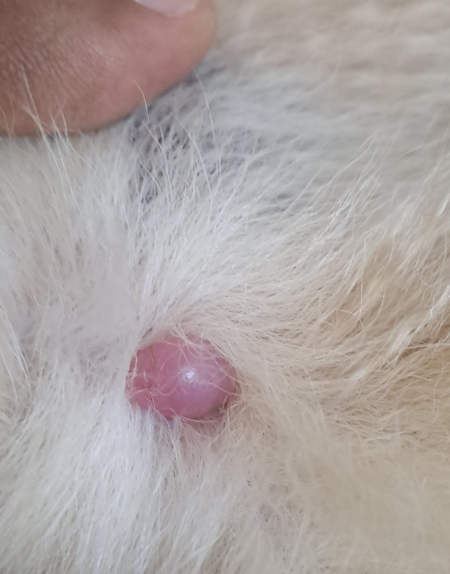
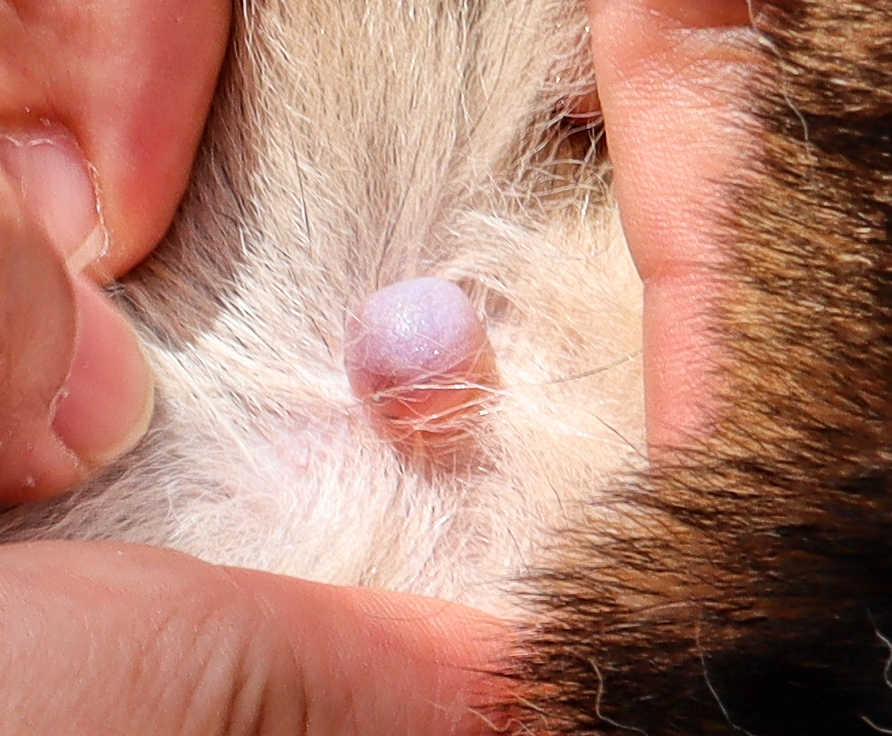
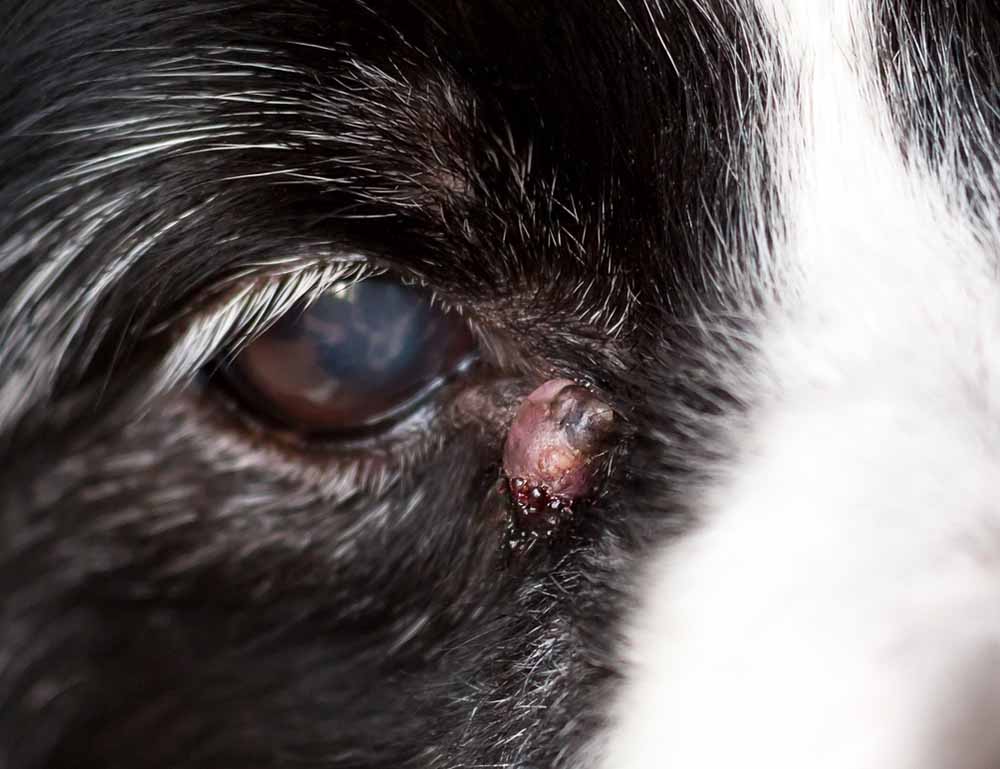
Dogs develop all kinds of cysts, some of which are fluid-filled and others that contain a thicker substance that resembles cottage cheese.
Canine cysts can appear anywhere on the body and may grow to a substantial size. However, most cysts remain quite small. If a cyst is drained or ruptures, it will refill quickly. While cysts usually do not need to be removed, removing one involves a surgical procedure to extract the cyst wall. Learn more about Cysts in Dogs.
Warts or sebaceous adenomas
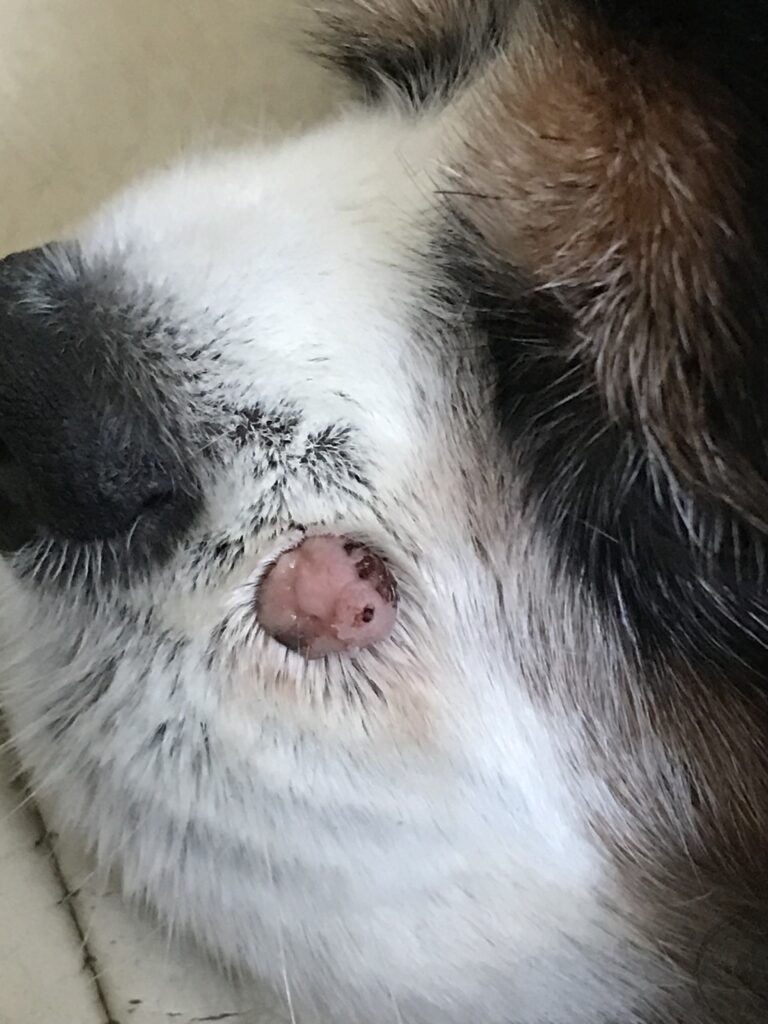
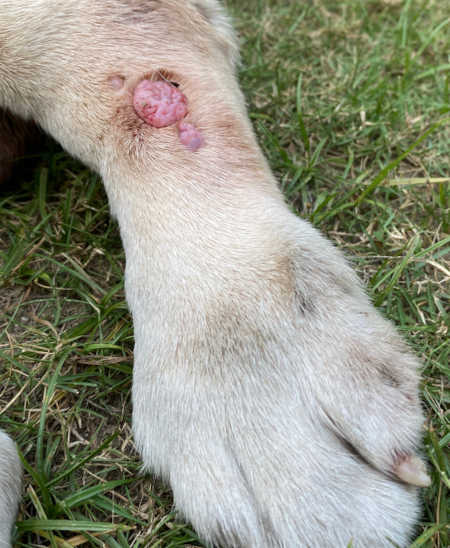
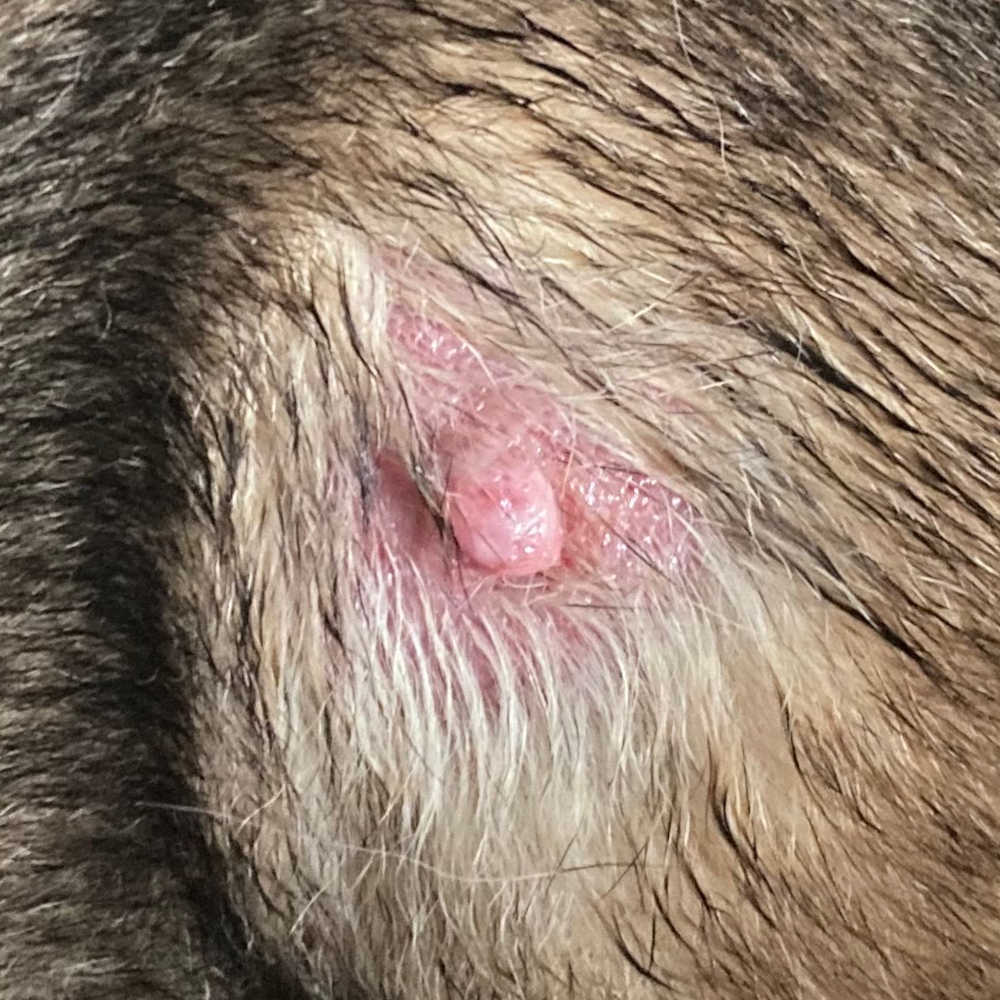
Warts tend to be light pink and can resemble small cauliflowers or brains. We tend to see warts in two dog populations: puppies and seniors. This is because both of these age groups struggle to fight off infections and warts are spread by a virus. For younger dogs, warts usually resolve within a few months. For older dogs, they may persist and grow slowly over time. Learn more about Warts in Dogs with pictures and veterinarian info.
Cancer
Cancerous lumps come in all shapes and sizes, as shown in the pictures below.
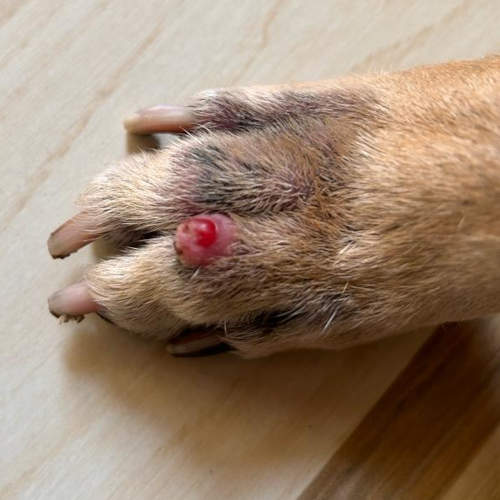
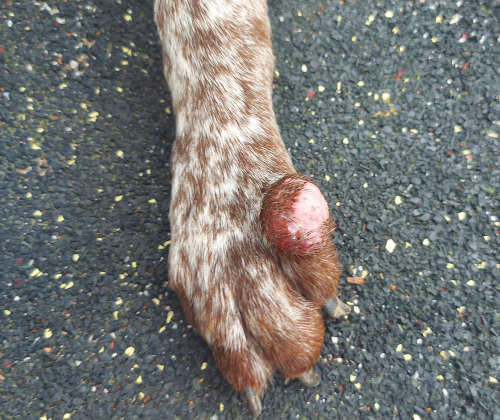
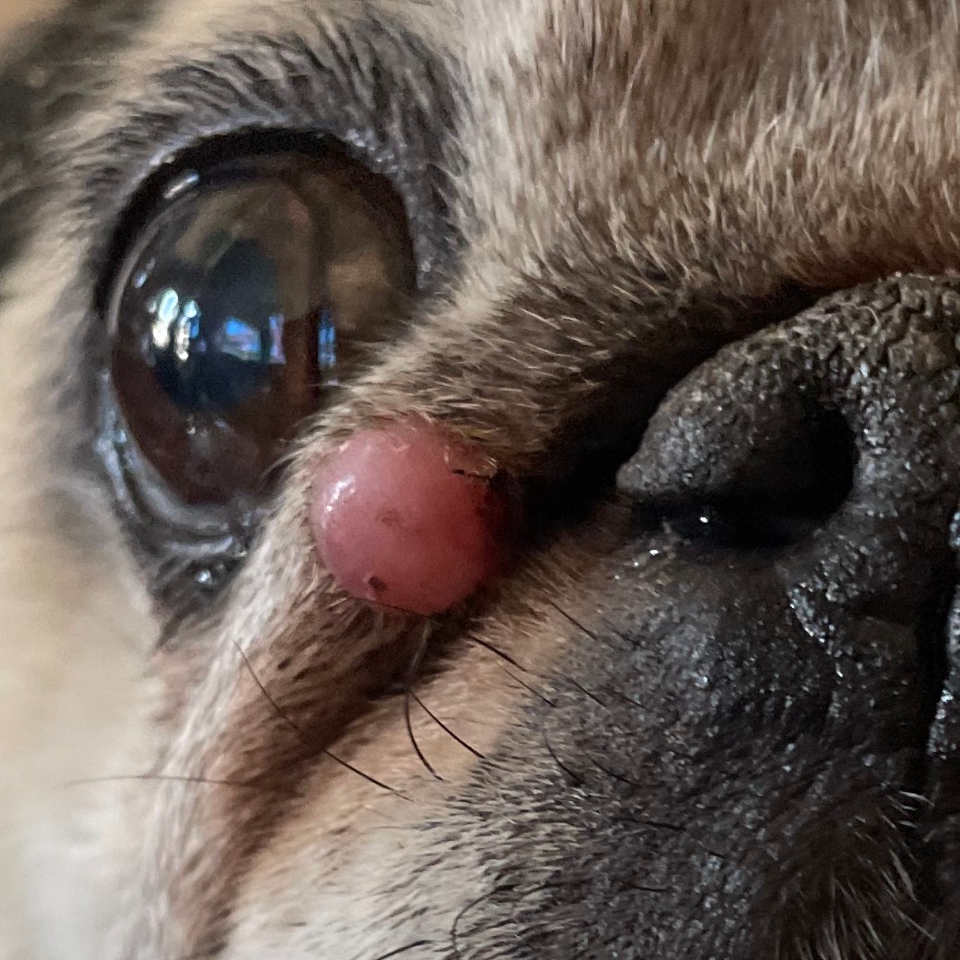
A black mole on a dog (rather than white, pink or red) is more likely to be a cancer called melanoma. Some of the more common places where malignant melanoma occurs include the mouth, near the claws, and sometimes within the eye. Learn more about Cancerous Lumps.
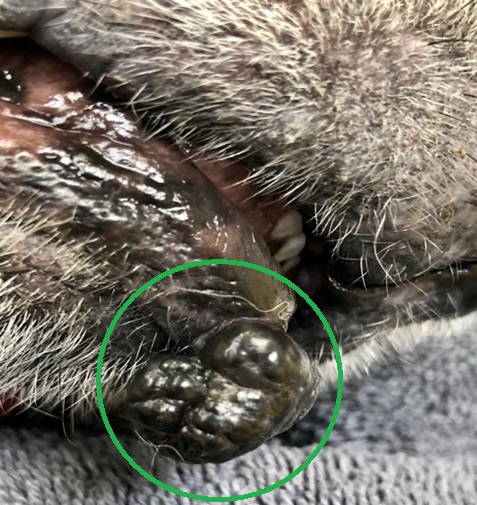
True nevi
A small black or brown mole on a dog may be a true nevus. These moles can appear on the face, flank, and paws, as well as other locations. As these lesions are benign, there is generally no need to intervene or provide treatment. However, a vet may discuss sampling the lesion to rule out anything more sinister, such as a melanoma.
Related post: Pictures of Common Lumps & Bumps on Dogs.
What to do when you find a mole or bump on your dog
1. Take pictures: When a new bump is noticed, it is a good idea to snap a photo, so you can assess if it is growing or changing over the coming days and weeks.
2. Consider a buster collar: If your dog has been licking or chewing at it, it is wise to use a buster collar to prevent this. This helps ensure the lesion does not become infected.
3. Reach out to your vet: A lesion that is not going away after a few days should be examined by a vet. Most of the time, new moles or warts will be something we monitor. Less often, your vet may discuss sampling or removal of the lump, particularly if they are concerned about cancerous tumors such as melanomas or mast cell tumors.
When is it ok to wait-&-see?
If youve only just noticed a small lesion and it is not bothering your dog, you may monitor it over a few days. It could be a small scab or insect sting, which will resolve quickly.
It is sensible to consult your veterinarian if the new lesion is persisting for over a week or if it seems to be quickly growing and changing. A consultation should also be booked if a lesion suddenly gets bigger or becomes infected.
Veterinary treatment, costs, and recovery
For many new lumps and bumps, the cost involved may be limited to the consult (about $60-100), as the vet may feel that the lesion is likely benign and needs no intervention. However, it is important to remember that the only way to know this is to sample and test the lesion.
If the mole needs to be investigated, this will be more costly. This can involve a Fine Needle Aspirate ($150-250) or biopsy ($200-400).
Removing a mole may be more costly, as it usually means the pet needs to be under an anesthetic. This can mean a bill of $400-900. This price should include the lab fees for analyzing the growth.
Frequently Asked Questions
What causes the growth of moles or bumps in dogs?
There is likely a large genetic component when it comes to the development of these lesions, but other factors can play a role, too.
- Exposure to sun. Dogs who spend a lot of time in the sun, particularly those who are short-furred, seem more prone to moles and skin tags.
- Weight gain. Dogs who carry more fat than they should can be more prone to developing certain lesions.
- Friction. When skin rubs against itself, especially in places like the armpits and groin, this can lead to skin tags developing.
Can moles or bumps on dogs be cancerous?
Yes, it is possible for these skin lesions to be malignant, which is why a vet visit should be booked for any lesion that is not going away quickly. Read our article about cancerous lesions and bumps in dogs.
How can I differentiate between a benign and malignant mole or bump?
There is no definitive way to do this without sampling the lesion and looking at it under the microscope. However, malignant lesions do share certain characteristics, such as being quick to grow, ulcerating, and becoming infected. Learn more: cancerous lesions and bumps.
Can moles or bumps on one dog spread to other dogs or humans?
No, moles cannot spread and are not contagious. Warts (papillomas), on the other hand, can spread from dog to dog.
Are certain dog breeds more prone to developing bumps?
Yes, there is a genetic component, so we will see certain lumps more often in certain breeds. Poodles, Schnauzers, and Golden Retrievers may be over-represented.
Dr Linda Simon (MVB MRCVS) has 10 years of experience as a veterinarian. She is a veterinary surgeon with a special interest in geriatric patient care, dermatology and endocrinology. She is a member of the British Royal College of Veterinary Surgeons. She graduated top of her class from UCD School of Veterinary Medicine in Dublin in 2013. Linda has also worked as a locum vet in a range of clinics, including 24 hour emergency clinics and busy charity clinics.
View all posts
Disclaimer: This website's content is not a substitute for veterinary care. Always consult with your veterinarian for healthcare decisions. Read More.
How to identify and remove a tick on your dog in 6 steps
Familiarize yourself with the common tick species for your area, including information such as what they look like and when theyre most active.
Tick life cycle
Ticks go through four distinct stages in their life cycle:
- Egg
- Six-legged larvae
- Eight-legged nymph
- Adult
Ticks can live anywhere between a few months to a few years, depending on the species. As arachnids, full-grown ticks possess eight legs. However, they only have six during the larvae stage. Thus, it is possible to only find six legs on a tick when you pull it off your dog.
While many dont live long, females may lay between 3,000 and 6,000 eggs. They usually breed right after a full meal and then lay eggs on their host, which is another reason to remove them immediately.
How dogs get ticks
Ticks are more likely found in moist regions with brush, tall grass, and woodlands. They tend to live in vegetation so they can latch onto dogs, cats, or humans as they walk by. Depending on where you live, tick season occurs at different times of year.
On the West Coast, you should look out for ticks all year. In the North and Midwest, tick season tends to fall between spring and fall. Warmer weather and rural living conditions breed a continuous tick season for much of the southern United States.
Thankfully, flea and tick prevention works against all species of ticks. Most veterinarians recommend using flea and tick control year-round just to be safe.
Ticks on Dogs: What to Look For
We all know that spring and summer are seasons to be on high alert for ticks. Dogs are particularly susceptible to tick bites and can also carry ticks into the house. Tick-borne diseasessuch asLyme disease, canine ehrlichiosis, Rocky Mountain Spotted Fever, and canine anaplasmosiscan affect both humans and dogs.
And although ticks are common throughout the country, people in some states are more at risk than others, according to the Centers for Disease Control (CDC). If you live in a state where Lyme disease cases are high or on the rise, you should be extra vigilant, take preventative measures, and check your dog and yourself for ticks frequently.
Knowing Which Ticks to Look Out For
There are at least fifteen species of tick in the United States. A few of these are considered harmful to humans and dogs:
- American Dog Tick is the most common tick in Pennsylvania, found throughout the state. Its also common in Southern states and coastal areas and is one of the most common ticks in Virginia. Although not a transmitter of Lyme disease, these ticks can transmit other serious, often deadly diseases to humans and dogs.
- Lone Star Tick lives in the underbrush in wooded areas and along rivers and creeks, although in Pennsylvania, its been reported near urban areas. Its also found in eastern areas of Virginia, east of the Blue Ridge Mountains. Lone star ticks can transmit diseases, including ehrlichiosis and tularemia, to dogs and humans.
- Black-legged Tick is commonly called the deer tick and can carry Lyme disease. Its found all over the Northeast and has recently expanded its range. Infestations have been found in several parts of Pennsylvanianorth, central, and southand northern parts of Virginia, including suburban areas.
How to Remove a Tick From a Dog
Its important to remove the tick promptly and correctly. Use rubbing alcohol on the area and delicately remove the tick with tick removal tweezers, making sure you also remove the head. If youre unsure how to do this properly, have your vet show you. Then youll be ready for next timeand there will most likely be a next time.
Can I Prevent Tick-Borne Diseases?
While you cant wipe ticks off the face of the earth, you can take preventative measures against ticks.
- Check your dog for ticks daily, or more if they spend a lot of time outside
- Keep yard mown and remove tall weeds
- To protect yourself, wear long pants and socks when out in woods or fields
- Your vet can recommend topical or systemic tick-control treatments. Be diligent and make sure to keep treatments up-to-date.
- Have your vet test for tick-borne diseases annually, even if your dog shows no symptoms.
Is it a tick? How to tell if its a tick on your dog or cat with pictures!
Can you come look? I think my dog has a tick on him!
My dog has a tick please come take it off NOW!
How do you tell if its a tick or a mole on my dog? And how do I remove it?
These are very common questions I am asked throughout spring and summer. With this summer being particularly tick-filled, at least in the Midwest, the concerns of pet owners are increased this year.
Good news in my experience 99% of suspected ticks are not ticks at all! They are age spots (AKA moles), nipples (yes, boy dogs have those too), skin tags, or other benign masses. Ironically, when I do find a tick on a dog, the owner never noticed it or suspected it!
So how can you tell if its a tick? There are three key features ticks have that other normal anatomy on dogs will not:
1- Ticks have legs. Eight of them. They are not insects, but arachnids. Yep, thats the spider family. You can see the eight legs. If the tick is dead, the legs will be curled up next to the body, but you can still see them. No legs? Not a tick!
2 Live ticks move. Even if they are attached, touch it and see if the legs wiggle. If its dead, they wont, as the legs will be contracted. If it is not attached, get ready for a chase! Ticks can run surprisingly fast! (think spider!)
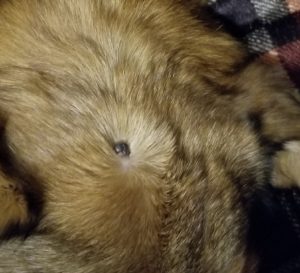
This is a benign lump, not a tick. Leave it alone!
3 Ticks are floppy. They attach with tiny mouths located in tiny heads. Even if its engorged, the base of attachment is still the little head. Most lumps and nipples on dogs have a wide base of attachment and cant be flopped (most, not all- some skin tags and nipples are very floppy!). If its really stuck to your dog and not moving, its not a tick. If you can wiggle it, it could be a tick or a floppy mass. Check for legs (see #1).
So youve confirmed it is a tick on your dog or cat. Now what? Light a match? Get essential oils? Say a chant? It is actually very simple to pull a tick off a dog or cat. You pull. Seriously, thats it. No twisting, no matches, nothing fancy. Get a tweezers if you cant get a good hold of it. Or, Ive removed many ticks from pets with my bare fingers in a pinch (when youre on a hike, you do what you gotta do!). Grasp firmly at the base, (ideally with a tweezers) as close to the skin as possible, and pull with confidence! You may get a little piece of skin the tick was attached to that means you got it all! If youre worried you left the head in, do not go digging into your pets skin. You can do much more damage with your search than a tiny piece of tick can do. The area where the tick was feeding may be inflamed or itchy for a few days, but rarely requires medical treatment.
The important thing to NOT do when removing a tick is squeeze the body. That can actually squish the disease-causing bacteria into your pet not where we want it! This is why you pinch at the base/head, which does not squeeze the body.
Good news ticks have to attach to a pet and feed for hours in order to transmit diseases like Lyme, Ehrlichiosis, Rocky Mountain Spotted Fever, or Anaplasmosis. So if you find a tick that is not engorged, chances are it has not been attached for long. Remove it and move on. There are no tests we can do on your pet that day that will tell us if he contracted a disease those take weeks to show up. If your pet is sick youll see symptoms of fever, lethargy, and a generally sick pet.
So youve boldly removed the tick from your pet. Congratulations! Now what?
These suckers are hard to kill! Rinsing them down a drain may not suffice Ive seen them crawling out of the drain! Flushing down a toilet is effective, as is dumping the the tick into a container of alcohol or insecticide.
Hopefully you have your pet on a product meant to kill or repel ticks, if your lifestyle and environment put your pet at risk. Ticks typically live in tall grass and brushy areas. That said, today I pulled a tick off of a 16 year old lap dog in a condo so you never know! Your vet can guide you on which tick prevention and killing products they carry and prescribe. Some common ones are Frontline (now available over-the-counter!), Seresto collars, Bravecto, Nexgard, Simparica, Advantix, and Vectra. Note that products like Comfortis, Trifexis, Sentinel, and Advantage work on fleas but have NO tick activity!
Pictures of lumps, skin tags, nipples, and moles that are all NOT ticks:

Two lumps, no ticks!

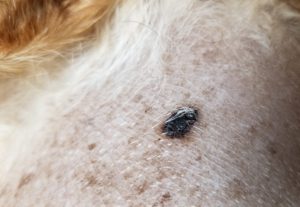
Save


